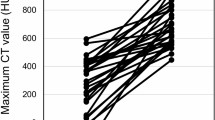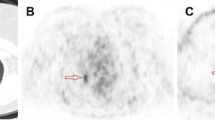Abstract
Objective
The aim of this study was to determine an optimal slice thickness that was efficient in revealing lobulation of malignant solitary pulmonary nodules (SPNs) on multi-slice spiral computed tomography (MSCT) images preliminarily.
Methods
Fifty patients with malignant SPNs (diameter ≤ 3 cm) underwent multidetector-row computed tomography of the chest in a single-breath-hold technique. The raw data were acquired with a collimation of 0.625 mm. Three sets of contiguous images were reconstructed with 1-, 2-, and 5-mm slice thickness, respectively. The lobulation sign of SPNs on the computed tomography (CT) images presented in 1-, 2-, and 5-mm slice thickness was compared. Using the 1-mm sections as the gold standard, an optimal slice thickness in revealing lobulation sign of SPNs was determined.
Results
The 1-mm-thick images CT revealed 98 lobulations (25 with chord distance < 1 mm; 30 with chord distance 1–2 mm; 43 with chord distance > 2 mm) of 45 malignant SPNs. 18 lobulations with chord distance < 1 mm presented in 2-mm-thick sections were as same as those in 1-mm-thick sections. Statistically significant difference in lobulations number was found between that revealed in 2-mm-thick images and that in 1-mm-thick images (P = 0.023 < 0.05). 16 lobulations with chord distance < 1 mm presented in 5-mm-thick sections were as same as that in 1-mm-thick sections. There was statistically significant difference in lobulations number between that revealed in 5-mm-thick images and that in 1-mm-thick images (P = 0.004 < 0.05). The 24 lobulations with chord distance 1-2 mm presented in 2-mm-thick sections were as same as that in 1-mm-thick sections. No statistically significant difference in lobulations number were found between that revealed in 2-mm-thick images and that in 1-mm-thick images (P = 0.261 > 0.05). 13 lobulations with chord distance 1-2 mm presented in 5-mm-thick sections were as same as that in 1- mm-thick sections. There was statistically significant difference in lobulations number between that revealed in 5-mm-thick images and that in 1-mm-thick images (P = 0.003 < 0.05). 40 lobulations with chord distance s>2 mm presented in 2-mm-thick sections were as same as that in 1-mm-thick sections. No statistically significant difference in lobulations number was found between that revealed in 2-mm-thick images and that in 1-mm-thick images (P = 0.631 > 0.05). 36 lobulations with chord distance >2 mm presented in 5-mm-thick sections were as same as that in 1-mm-thick sections. There was no statistically significant difference in lobulations number between that revealed in 5-mm-thick images and that in 1-mm-thick images (P = 0.264 > 0.05).
Conclusion
It is suggested that the use of 1-mm slice thickness is suitable in revealing lobulations with chord distance < 1 mm. A 2-mm slice thickness is suggested to be used in revealing lobulations with chord distance 1-2 mm and 5-mm slice thickness to be used in revealing lobulations with chord distance > 2 mm.
Similar content being viewed by others
References
Iwano S, Makino N, Ikeda M, et al. Solitary pulmonary nodules: optimal slice thickness of high-resolution CT in differentiating malignant from benign. Clin Imaging, 2004, 28: 322–328.
Brundage MD, Davies D, Mackillop WJ. Prognostic factors in nonsmall cell lung cancer: a dacade of progress. Chest, 2002, 122: 1037–1057.
Li SJ, Zhu F, Zhu Y, et al. Assessing no-surgical treatment response in bronchogenic carcinoma with contrast material-enhanced computed tomography. Chinese-German J Clin Oncol, 2010, 9: 262–265.
Chen AP, Xiao XS, Liu SY. The development of low-dose CT screening for lung cancer. J Pract Radio (Chinese), 2008, 24: 1131–1133.
Furuya K, Muray S, Sceda H, et al. New classification of small pulmonary nodules by margin characteristics on high-resolution CT. Acta Radiol, 1999, 40: 496–504.
Li SJ, Xiao XS, Liu SY, et al. The inhomogeneous perfusion of the solitary pulmonary nodules. Chin J Radiol (Chinese), 2008, 42: 862–865.
Jemal A, Siegel R, Ward E, et al. Cancer statistics, 2006. CA Cancer J Clin, 2006, 56: 106–130.
Li SJ, Zhu F, Liu DB, et al. Preliminary assessing no-surgical treatment response in bronchogenic carcinoma with changes in enhancement pattern. J Clin Radio (Chinese), 2010, 29: 1336–1339.
Li SJ, Zhu F, Cui XF, et al. Preliminary assessing no-surgical treatment response in bronchogenic carcinoma with three-phase contrast material-enhanced magnetic resonance imaging. Chinese-German J Clin Oncol, 2010, 9: 444–447.
Zhao X, Ju Y, Liu C, et al. Bronchial anatomy of left lung: a study of multi-detector row CT. Surg Radiol Anat, 2009, 31: 85–91.
Cui Y, Ma DQ, Liu WH. Value of multiplanar reconstruction in MSCT in demonstrating the relationship between solitary pulmonary nodule and bronchus. Clin Imaging, 2009, 33: 15–21.
Bai RJ, Cheng XG, Qu H, et al. Solitary pulmonary nodules: comparison of multi-slice computed tomography perfusion study with vascular endothelial growth factor and microvessel density. Chin Med J, 2009, 122: 541–547.
Ding J, Xiao XS, Li HM, et al. Low-dose MSCT: application to threedimension imaging of central airways. Chin J Med Comput Imaging (Chinese), 2006, 12: 23–27.
Author information
Authors and Affiliations
Corresponding author
Rights and permissions
About this article
Cite this article
Li, S., Li, C., Wang, X. et al. The optimal slice thickness of CT in revealing lobulation of malignant solitary pulmonary nodules. Chin. -Ger. J. Clin. Oncol. 10, 559–562 (2011). https://doi.org/10.1007/s10330-011-0847-y
Received:
Revised:
Accepted:
Published:
Issue Date:
DOI: https://doi.org/10.1007/s10330-011-0847-y




